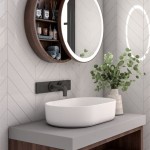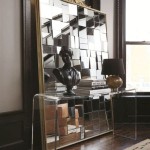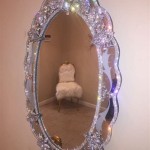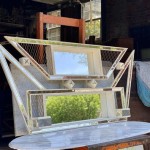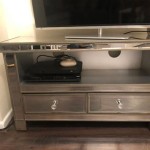How High To Hang A Bathroom Light Over The Mirror: A Comprehensive Guide
Proper bathroom lighting is essential for both functionality and aesthetics. It impacts everything from daily grooming routines to the overall ambiance of the space. One of the most critical aspects of bathroom lighting design is determining the optimal height for the light fixture positioned above the mirror. This positioning directly affects the quality of light cast on the face, influencing tasks such as shaving, applying makeup, and skincare. Hanging the light too high or too low can create shadows, glare, and an uneven distribution of illumination, ultimately compromising the purpose of the lighting.
This article aims to provide a comprehensive guide on how to determine the appropriate height for hanging a bathroom light fixture over the mirror. This process involves considering several factors, including the height of the vanity, the type of light fixture, the height of the individuals using the space, and relevant building codes. By carefully evaluating these elements, one can ensure that the bathroom lighting is both functional and visually appealing.
Understanding the Importance of Vertical Placement
The vertical placement of a bathroom light fixture over the mirror is paramount for achieving optimal illumination. Light that is positioned too high can create harsh shadows under the eyebrows and nose, making it difficult to see clearly for tasks requiring precision. Conversely, a light that is placed too low can shine directly into the eyes, causing glare and discomfort. An ideal height ensures even distribution of light across the face, minimizing shadows and providing comfortable illumination for grooming activities.
Furthermore, the vertical placement of the light fixture contributes significantly to the overall aesthetic of the bathroom. A correctly positioned light can enhance the visual balance of the space, complementing the vanity, mirror, and other bathroom fixtures. Conversely, a poorly positioned light can disrupt the visual harmony, making the bathroom feel unbalanced or improperly designed. Therefore, careful consideration of the vertical placement is not just a matter of functionality but also a crucial aspect of bathroom design.
The type of light fixture used also impacts the ideal hanging height. For instance, a linear vanity light bar, which distributes light horizontally, may require a slightly different placement compared to individual sconces mounted above the mirror. Understanding the specific characteristics of the light fixture is essential for determining the optimal height.
Key Considerations Before Installation
Before installing a bathroom light fixture above the mirror, several factors should be carefully evaluated to ensure optimal placement. These factors include the height of the vanity, the type of light fixture, the height of the individuals using the space, and relevant building codes.
Firstly, the height of the vanity plays a crucial role in determining the ideal hanging height. Standard vanity heights typically range from 30 to 36 inches. The light fixture should be positioned in relation to the vanity to ensure that it provides adequate illumination for the user while maintaining visual balance. A general rule of thumb is to position the center of the light fixture approximately 75 to 80 inches above the floor. However, this measurement may need to be adjusted depending on the specific vanity height.
Secondly, the type of light fixture used affects the optimal hanging height. Linear vanity light bars, sconces, and pendant lights each have distinct characteristics that influence how they distribute light. Linear vanity light bars typically provide a more even distribution of light across the face and may require a slightly lower placement compared to individual sconces. Sconces, on the other hand, can be positioned to provide more targeted illumination. Pendant lights are less commonly used above mirrors due to potential obstruction of view, but when used, they require careful consideration of height to avoid creating shadows.
Thirdly, the height of the individuals using the space should be taken into account. The light fixture should be positioned so that it provides adequate illumination without causing glare or discomfort. If there are significant differences in height among users, it may be necessary to compromise on the hanging height or consider adjustable lighting options.
Finally, relevant building codes should be consulted to ensure compliance. Building codes may specify minimum and maximum heights for electrical fixtures in bathrooms. Failure to comply with these codes can result in safety hazards and legal issues. It is advisable to consult with a qualified electrician or building inspector to ensure that the installation is in accordance with all applicable codes.
Step-by-Step Guide to Determining the Ideal Height
Determining the ideal height for hanging a bathroom light over the mirror requires a systematic approach. This process involves measuring, planning, and testing to ensure optimal placement. The following step-by-step guide provides a framework for achieving this goal.
Step 1: Measure the Vanity Height: Begin by measuring the height of the vanity from the floor to the top of the countertop. This measurement will serve as a reference point for determining the overall height of the light fixture. Standard vanity heights are typically between 30 and 36 inches, but custom vanities may vary. Accurate measurement is crucial for ensuring proper alignment.
Step 2: Determine the Average User Height: Consider the average height of the individuals who will be using the bathroom. This can be determined by measuring the height of each user and calculating the average. This measurement is important for ensuring that the light fixture is positioned at a height that provides adequate illumination without causing discomfort.
Step 3: Calculate the Ideal Fixture Center Height: As a general guideline, the center of the light fixture should be approximately 75 to 80 inches above the floor. However, this measurement may need to be adjusted based on the vanity height and the average user height. For example, if the vanity is taller than average, the light fixture may need to be positioned slightly higher to maintain proper balance. Conversely, if the vanity is shorter than average, the light fixture may need to be positioned slightly lower.
Step 4: Consider the Light Fixture Type: The type of light fixture used affects the optimal hanging height. Linear vanity light bars typically provide a more even distribution of light and may require a slightly lower placement compared to individual sconces. Sconces, on the other hand, can be positioned to provide more targeted illumination. For linear vanity light bars, the bottom of the fixture can be around 70 inches from the floor. For sconces, the center of the fixture should align with eye level of the average user which should be around 60 to 66 inches from the floor. This should provide direct and even light across the face.
Step 5: Temporarily Position the Fixture: Before permanently installing the light fixture, it is advisable to temporarily position it at the calculated height and assess the illumination. This can be done by using tape or other temporary fasteners to hold the fixture in place. Observe the quality of light cast on the face and make adjustments as needed. Pay attention to any shadows, glare, or uneven distribution of light.
Step 6: Adjust the Height as Needed: Based on the temporary positioning, make any necessary adjustments to the height of the light fixture. Slight adjustments can make a significant difference in the quality of light. Consider enlisting the help of another person to provide feedback on the illumination from different angles.
Step 7: Permanently Install the Fixture: Once the optimal height has been determined, proceed with the permanent installation of the light fixture. Follow the manufacturer's instructions carefully and ensure that all electrical connections are properly secured. If you are not comfortable working with electricity, it is advisable to hire a qualified electrician to perform the installation.
Step 8: Verify Compliance with Building Codes: Before completing the installation, verify that the light fixture is in compliance with all applicable building codes. Consult with a qualified electrician or building inspector if you have any questions or concerns. Ensure all local electrical codes are adhered to.
By following these steps, one can ensure that the bathroom light fixture is positioned at the optimal height for both functionality and aesthetics. Careful planning and attention to detail will result in a well-lit and visually appealing bathroom space.
In addition to the above considerations, it is important to choose a light fixture that is appropriate for the size and style of the bathroom. A fixture that is too large or too small can disrupt the visual balance of the space. Similarly, a fixture that does not complement the overall style of the bathroom can detract from the overall aesthetic.
Furthermore, consider the color temperature of the light bulbs used in the fixture. Color temperature is measured in Kelvin (K) and ranges from warm (2700K) to cool (6500K). For bathroom lighting, a color temperature of around 3000K to 4000K is generally recommended. This provides a natural and flattering light that is ideal for grooming tasks. Warmer light can make skin look aged and cooler light can make skin look pale.

Guide To Hanging Bathroom Vanity Lighting And Mirrors Liven Design

How High To Place Your Bathroom Fixtures Inspired Style

How High To Place Your Bathroom Fixtures Inspired Style

How High Should You Hang The Mirror In A Bathroom With Photos Design Morsels

Vanity Light Height The Home Depot

How High To Place Your Bathroom Fixtures Inspired Style

How High To Place Your Bathroom Fixtures Inspired Style

Your Guide To Bathroom Lighting

Your Guide To Bathroom Lighting
Complete Bathroom Lighting Guide For Design Success Your Designer Bff

